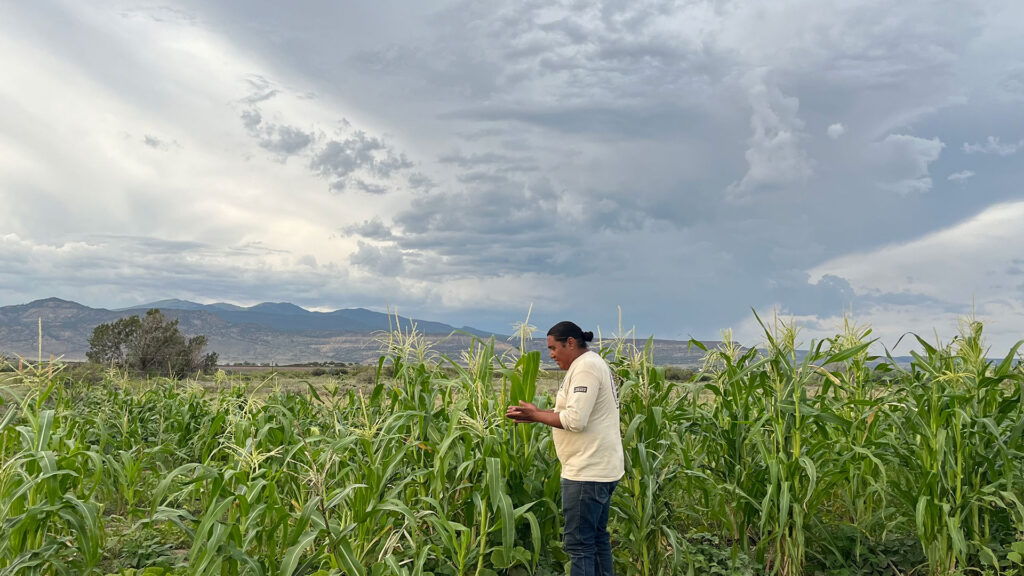‘Home’s the place we head for in our sleep.’

Yesterday, we visited the Pueblo of Acoma and saw the field we filmed in early April in its full green glory. And while the monsoon rains haven’t been as robust there this summer as farmers would hope, we were happy to see clouds building over Kaweshtima — also known as Mount Taylor — and the mesas.
You might remember that in this segment with farmer Aaron Lowden, we learned that when the higher elevation lands are dry, the elk head down to the fields.
Sure enough, as Lowden showed us yesterday evening, an elk had gotten into the field and chowed down on the tops of the corn. Along with Domonique Lowden, Acoma Ancestral Lands Farm Coordinator, and others, they’re working to build a new elk fence. If you’re not already familiar with the values and work of the Ancestral Lands Conservation Corp, make sure you check them out!
Some of the news to check out this week:
• “New Mexico Gas Co. parent company announces intent to sell utility to private equity firm” (Nicholas Gilmore, Santa Fe New Mexican)
• “Forecast: Reduced wildfire risk in New Mexico in August, as much of the West burns” (Patrick Lohmann, Source NM)
• “Utah Holds All Wildfire Resources In State. Incoming Dry Lightning And Record Temps Have Fire Managers Puckered.” (The Hot Shot Wake Up Newsletter)
• “FEMA reaches $1 billion in payouts, settles seven lawsuits for northern NM fire victims” (Patrick Lohmann, Source NM)
• “$100M headed to Ruidoso after lone special session bill signed by Gov. Lujan Grisham” (Leah Romero, Source NM)
• “Navajo Nation, Havasupai Tribe condemn transportation of uranium ore on tribal land” (Shondiin Silversmith, AZ Mirror)
• “Water quality commissioner with ties to oil and gas industry won’t vote in fracking waste case” (Nicholas Gilmore, Santa Fe New Mexican)
• “Hearing on proposal for expanded water reuse continues” (Megan Gleason, Albuquerque Journal)
• “Taos residents say State Engineer slow to address water diversions” (Phaedra Haywood, Santa Fe New Mexican)
• “New Mexico cracks down on drinking water quality violations” (Nicholas Gilmore, Santa Fe New Mexican)
• “Don’t call it a comeback. These animals have been here for years” (Kyle Cooke, Rocky Mountain PBS)
• “More Americans are moving into flood and fire hot spots” (Sarah Kaplan, The Washington Post)
• “Antarctic temperatures soar 50 degrees above norm in long-lasting heat wave” (Kasha Patel, The Washington Post)
• “Inside the Petrostate Hosting This Year’s Global Climate Negotiations” (Max Bearak and Nanna Heitmann, The New York Times)
• “Climate change deniers make up nearly a quarter of US Congress” (Oliver Milman and Dharna Noor, The Guardian)
Be sure to check out Carina Julig’s story in the Santa Fe New Mexican about Los Alamos County. According to the story:
“Thanks largely to the lab’s construction spending, the county’s annual operating budgets have soared in recent years, rising from $199 million in fiscal year 2020 to $382 million in the past fiscal year.
While pit production, too, might seem to be a financial boon to the county, the opposite is true.” And please read Shaun Griswold’s story, “At least 973 Native American children died at U.S.-run boarding schools between 1871-1969.” Here’s a short excerpt:
“In the update to the report commissioned in 2021, the Interior Department estimates that more than $23.3 billion was appropriated by Congress to run an education system that forced at least 18,624 children from tribes across the country to schools where they were assaulted, forced to labor and assimilated until their entire culture was destroyed.
The report, which acknowledges that all of this new data remains incomplete, states that 973 children died in that period.”
There are a lot of things to write about that shameful legacy in our country, and its continued impact on people. But I’m going to leave the final word to Louise Edrich, who wrote “Home’s the place we head for in our sleep.” Read her poem, “Indian Boarding School: The Runaways” on the Poetry Foundation’s website.
P.S. If a friend forwarded you this message, sign up here to receive the newsletter yourself. You can also read recent newsletters online. And if you miss us throughout the week, follow Our Land on Instagram.


